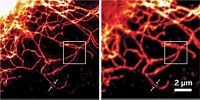Advertisement
Grab your lab coat. Let's get started
Welcome!
Welcome!
Create an account below to get 6 C&EN articles per month, receive newsletters and more - all free.
It seems this is your first time logging in online. Please enter the following information to continue.
As an ACS member you automatically get access to this site. All we need is few more details to create your reading experience.
Not you? Sign in with a different account.
Not you? Sign in with a different account.
ERROR 1
ERROR 1
ERROR 2
ERROR 2
ERROR 2
ERROR 2
ERROR 2
Password and Confirm password must match.
If you have an ACS member number, please enter it here so we can link this account to your membership. (optional)
ERROR 2
ACS values your privacy. By submitting your information, you are gaining access to C&EN and subscribing to our weekly newsletter. We use the information you provide to make your reading experience better, and we will never sell your data to third party members.
Analytical Chemistry
Quantum dots could expand live imaging
Particles strongly emit short-wavelength infrared light, which penetrates tissue deeply
by Stu Borman
April 17, 2017
| A version of this story appeared in
Volume 95, Issue 16
When it comes to imaging live tissue, short-wavelength infrared (SWIR) radiation penetrates farther and scatters less than more-traditional near-IR and visible light. But a lack of agents that fluoresce brightly in the SWIR region (about 1,000 to 2,000 nm) has impeded the development of this type of imaging in the body. Moungi G. Bawendi, Oliver T. Bruns, and Thomas S. Bischof of MIT and coworkers have now created quantum dots that could expand SWIR live imaging (Nat. Biomed. Eng. 2017, DOI: 10.1038/s41551-017-0056). They coated InAs cores with CdSe, CdS, CdSe-ZnSe, or CdS-ZnSe single or double layers and derivatized the resulting quantum dots with organic functional groups to customize them—for instance, to have long blood circulation times. The quantum dots emit SWIR radiation about an order of magnitude more strongly, are more stable, and have narrower and more tunable emission spectra than previous SWIR probes. In live imaging, the quantum dots also allow faster acquisition speeds and higher sensitivity than previous SWIR emitters. In live mice and in real time, the researchers used the emitters to measure metabolic turnover rates in several organs simultaneously, to quantify heartbeat and breathing rates, and to map brain vasculature. The quantum dots have constituents such as cadmium that aren’t necessarily suitable for human use, but the researchers hope to eventually make versions of the particles that are safe for use in the clinic.




Join the conversation
Contact the reporter
Submit a Letter to the Editor for publication
Engage with us on Twitter